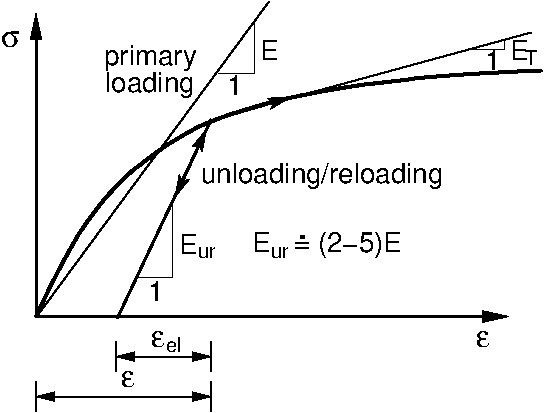Nonlinear Models
The basic nonlinear models can be again divided into two groups.
The first class of models originates from the classical Mohr-Coulomb failure criterion. In particular, the Drucker-Prager, Mohr-Coulomb and Modified Mohr-Coulomb models fall in this category. These models can also model the hardening and softening. A common feature to these models is the evolution of unbounded elastic strains when loaded along the geostatic axis. This is evident from the figure below that shows projections of the yield surfaces into deviatoric and meridian planes, respectively. The Hoek-Brown material model works on a similar principle, but the projection into the meridional plane is nonlinear. An example of the effect of the selected model is given here.
The second group of basic material models is represented by the Modified Cam-clay, Generalized Cam clay and Hypoplastic clay models employing the concept of the critical state of soils.
 Projection of yield surfaces into (a) deviatoric, (b) meridian plane
Projection of yield surfaces into (a) deviatoric, (b) meridian plane
Employing nonlinear models allows us to capture the typical nonlinear response of soils.
These models describe the evolution of permanent (plastic) deformation of a soil material. The onset of plastic deformation is controlled by so-called yield surface. The yield surface can be either constant (elastic-perfectly plastic material), or it can depend on the current state of stress (material with hardening/softening).
 Stress-strain diagram for nonlinear models
Stress-strain diagram for nonlinear models
Unlike the modified linear model the nonlinear models require specifying only the elastic modulus. A drop in the material stiffness is a result of evolution of plastic strains and corresponding redistribution of stresses. This consequently yields an instantaneous tangent material stiffness as a function of the current state of stress represented in the Figure below by an instantaneous tangent modulus ET.
In addition to basic material parameters decribed in section "Elastic model" the nonlinear models call for the introduction of certain strength characteristics of the soil needed in the definition of a given yield surface. With reference to the first group of materials the following parameters must be specified.
φ | - | angle of internal friction [°] |
c | - | cohesion of soil [kPa] |
ψ | - | dilation angle [°] |
The angle of internal friction and cohesion determine the onset of plastic deformation. The angle of dilation controls the evolution of plastic volumetric strain (dilation).